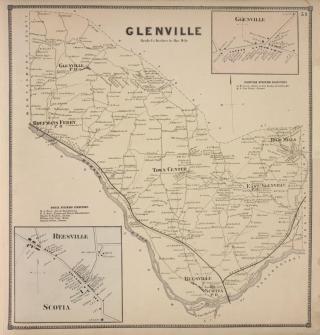Glenville Becomes a Town: The Act of 1820

In the early 19th century, the city of Schenectady consisted of four wards: Wards 1 & 2 comprised what the city is today, with Rotterdam making the third ward and Glenville the fourth.
Both the third and fourth wards were thinly populated land which was owned by the city and known as the "Common Lands". They were essentially wooded lands where Schenectady's residents could cut trees for timber or fuel and use the land to pasture livestock.As the population grew however, problems such as uncontrolled cutting began to take its toll on the finite natural resources.Additionally, the city was in debt needed to raise money, and great interest grew in the land. The city's leaders felt the best way to sell the land was by auction.
At the time, the city was governed by a Council governed by two alderman from each ward. In 1816, the city tried to find a resolution to the problems of the commons but the population in the first and second wards could not agree with the farmers in the third and fourth wards.
By May of 1819, the Council formed a new committee consisting of one member from each ward. Representing the fourth ward was Alexander Jacobs Sanders.The solution proposed to split the third and fourth wards into separate towns from the city and divide the commons equally between the towns and the city. This would allow the towns and the city to lease their own respective portions of the commons as they saw fit. The proposal received public support on a meeting held on December 31, 1819. On January 1, 1820, the Council met and resolved to petition the State legislature to alter the city's charter.
The Act of 1820
In 1820, the United States was in the midst of the "Era of Good Feelings" that followed the War of 1812. James Monroe was ending his first term as president, and Congress- split of the issue of slavery, was working on the Missouri Compromise.
In Albany, Governor DeWitt Clinton opened the 43rd session with an address to the Legislature with an address where he reported the progress of the Erie Canal. This session would end with the Legislature taking up the issue of creating the Town of Glenville.
The petition from the City of Schenectady was read before the Assembly on March 14 and referred to committee for consideration. On March 24th, the Assembly received notice from residents who disagreed with the solution.Nevertheless, the bill was passed from the assembly on April 8th.
The Senate passed an amended version of the bill on April 12, 1820 and sent it back to the Assembly for approval on April 14th, the final day for the legislative session, for final approval.The session concluded at 4pm with the measure being passed, and thus Glenville was born.
The first Glenville town meeting was held on January 2, 1821 at the tavern of Nicholas S. Van Patten (at the corner of Sacandaga and Ridge Roads). At the meeting, officers were selected and a vote was taken to give the trustees the power to lease the new lands in 20-acre lots.
Glenville and Schenectady divided the commons into two strips: the North and the South. Schenectady retained the southern lands and divided its portion into 50 acre lots.Glenville distributed its lands in the north by auction to the voters, but many were maintained as wooden lots since it was difficult to develop a farm on 20 acres, especially in the Glenville Hills.
The town's first supervisor was Albert Vedder and was selected at the Janaury 2nd meeting.

